Trees Birds Mammals Fish Amphibians Reptiles
Wild Algarve
Bookshop
Cortinarius obtusus (Fr.) Fr. - Blunt Webcap
Phylum: Basidiomycota - Class: Agaricomycetes - Order: Agaricales - Family: Cortinariaceae
Distribution - Taxonomic History - Etymology - Toxicity - Identification - Reference Sources
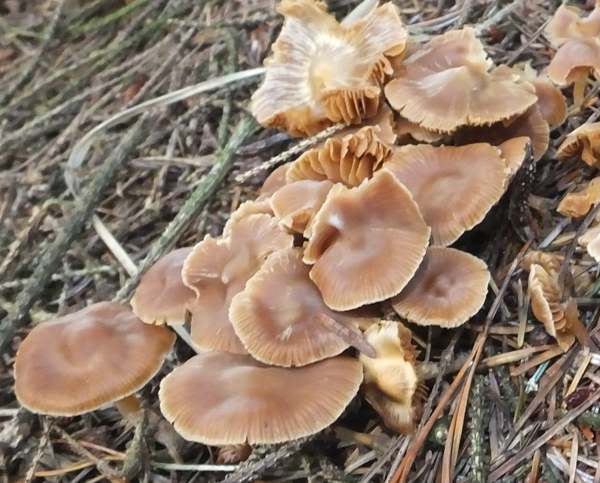
Cortinarius obtusus is an occasional find in Britain and Ireland. It grows on soil, usually in large trooping groups, in conifer forests and sometimes under birches.
Distribution
An uncommon species in most areas, but locally abundant, the Blunt Webcap is recorded rather more frequently in Scotland but is found occasionally in conifer plantations throughout most parts of Britain and Ireland.
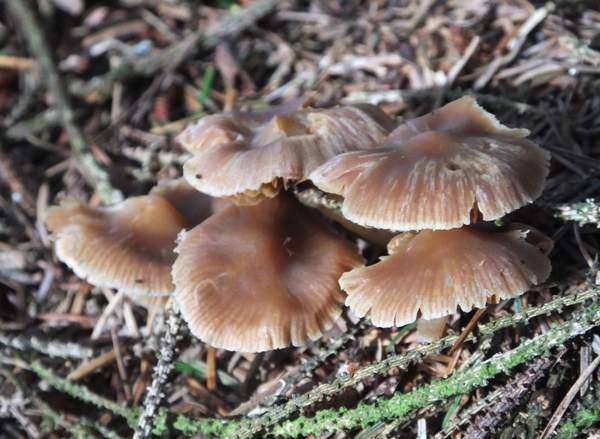
Taxonomic history
When Swedish mycologist Elias Magnus Fries described this webcap in 1821 he gave it the binomial scientific name Agaricus obtusus. (Vast numbers of gilled fungi were dumped into the Agaricus genus in the early days of fungal taxonomy; most have since been moved to other genera leaving in the present-day Agaricus genus a much smaller number of gilled mushrooms that are sometimes referred to as the 'true mushrooms'.) Fries later (1821) transferred this spevcies to the genus Cortinarius, when its scientific name became Cortinarius obtusus, the name by which it is generally referred to today.
Synonyms of Cortinarius obtusus include Agaricus obtusus Fr., Cortinarius pseudostriatulus Rob. Henry, Gomphos obtusus (Fr.) Kuntze, and Hydrocybe obtusa (Fr.) Wunsche.
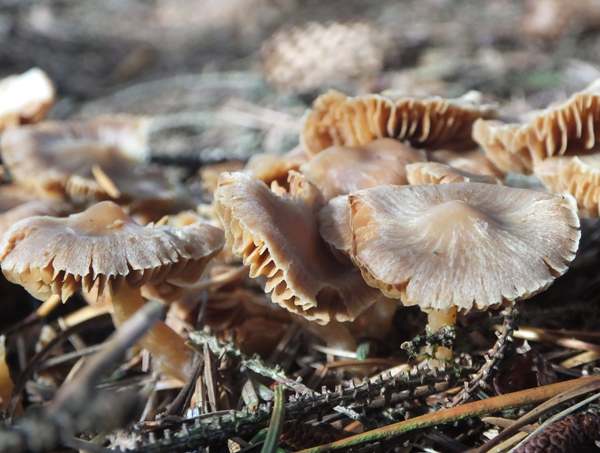
Etymology
The generic name Cortinarius is a reference to the partial veil or cortina (meaning a curtain) that covers the gills when caps are immature. In the genus Cortinarius most species produce partial veils in the form of a fine web of radial fibres connecting the stem to the rim of the cap rather than a solid membrane.
Just as you might expect, the specific epithet obtusus refers to the obtuse (blunt) umbonate form of the cap of this webcap mushroom.
Toxicity
This mushroom is of unknown edibility and should be regarded as 'suspect' because several species in this genus contain dangerous toxins.
Identification guide
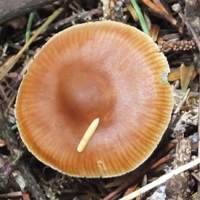 |
Cap
The red-brown to orange-brown or yellow-brown cap, 2 to 5cm in diameter with pellucid-striate margin half-way to centre, is at first campanulate or conical becoming broadly convex at maturity, usually with a blunt umbo. The margin has a pale edge.. |
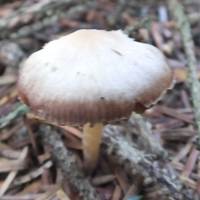 |
The whole of the cap surface is hygrophanous, becoming very pale (left) when dry. |
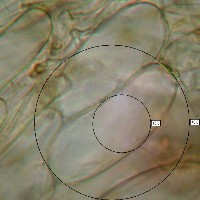 |
Pileipellis
The subpellis comprises regular bloated cells typically 40µm x 15µm
|
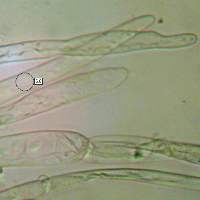 |
The pileipellis surface itself consists of raised elongated elements typically 5 - 8µm in diameter.
|
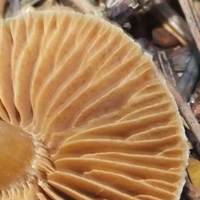 |
Gills
The modertely-spaced emarginate gills are yellowish brown with paler edges. The gill trama consist of regular incrusted cells.
Basidia
Four spored. |
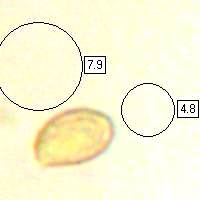 |
Spores
Amygdaliform (almond-shaped), 7-9 x 4.5-5.3µm, with a noticeably verrucose (roughened) surface; dextrinoid.
Spore print
Rusty reddish-brown. |
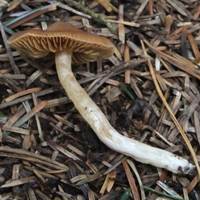 |
Stem
The stem, which is white initially and gradually turns yellowish, is typically 3 to 6mm in diameter and 4 to 10
cm long. |
Odour/taste |
Stem base smells initially of radish and later iodoform; taste not distinctive.. |
Habitat & Ecological role |
Possibly saprophytic or mycorrhizal (?), often in large trooping groups, usually under coniferous trees, especially spruce and pine. |
Season |
August to November in Britain and Ireland. |
Similar species |
Many other webcaps within the sub-genus Telamonia have brown umbonate caps, and so all macroscopic and microscopic characters must be checked to minimise the risk of misidentification. |
Reference Sources
Fascinated by Fungi, 2nd Edition, Pat O'Reilly 2016, reprinted by Coch-y-bonddu Books in 2022.
Funga Nordica, Henning Knudsen and Jan Vesterholt, 2008.
Fungi of Switzerland Agarics, part 3: Cortinariaceae, Breitenbach, J., Kränzlin, F.
Dictionary of the Fungi; Paul M. Kirk, Paul F. Cannon, David W. Minter and J. A. Stalpers; CABI, 2008
Taxonomic history and synonym information on these pages is drawn from many sources but in particular from the British Mycological Society's GB Checklist of Fungi.
Top of page...
Fascinated by Fungi. Back by popular demand, Pat O'Reilly's best-selling 450-page hardback book is available now. The latest second edition was republished with a sparkling new cover design in September 2022 by Coch-y-Bonddu Books. Full details and copies are available from the publisher's online bookshop...